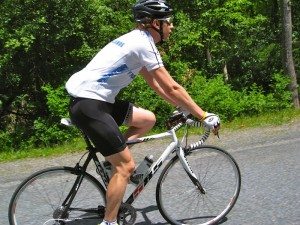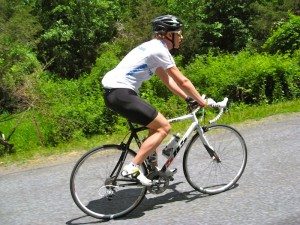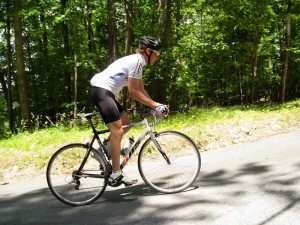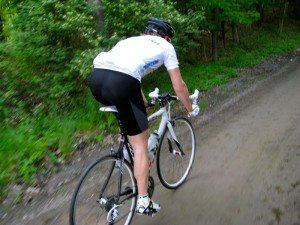Climbing hills on a bike is perhaps the toughest challenge a rider will undertake. It's no secret that the big mountains are the deciding factors in the biggest bike races in the world, and the skinny climbers that can conquer those mountains are often on the top step of the podium. For us mere mortals, the struggle to find our way up into the clouds can be made easier by utilizing different climbing positions for different situations. We'll explore a few of the most common and explain their uses.

Hands On The Hoods
The hands on the hoods position is a variant of your regular riding position. Because your reach is the furthest forward of any other point on the bike, it is an excellent position to slide forward on the saddle and engage your quads, allowing you to climb with lots of power. This position will also decrease the hip angle, allowing a little more recruitment of the hip flexors (particularly the powerful Psoas muscle.) Unfortunately, climbing in this position tends to bump the heart rate up, tire the legs more quickly and can be uncomfortable on the “undercarriage.” It is a great position for closing a slowly opening gap though.
 Hands On The Tops
Hands On The Tops
Climbing with your hands on the flat parts of the bar, next to the stem is sometimes equated to the “mountain bike position.” In this case, you'll have your hands as far back on the bar as possible, so you'll have a large range of positions on the saddle to utilize. Slide forward to engage the quads (as above, but this position will further open the hip angle) or slide back to the tail of the saddle to engage the large and powerful glute muscles and hamstrings. While these muscles are very powerful, they tend to fatigue more slowly than the quads, so this is a position you'll be spending some time in if your climbs are longer than a few hundred meters in length. The other bonus of climbing on the tops is the ability to sit up higher and open your chest, allowing you to take a very full breath, getting every molecule of oxygen into your lungs.
 Out Of The Saddle
Out Of The Saddle
Climbing out of the saddle is the quintessential “attacker's position.” Watch any televised race and you'll often hear of someone “dancing on the pedals” as they scream up impossible grades. Climbing out of the saddle allows you to put in huge accelerations, put out lots of wattage, but it will also tire you out very quickly. Because of the high physiological toll this technique takes, it's usually only used as an attacking technique or a change of pace technique. If the climb is extremely long, very often you'll find yourself tiring of one position or another, and standing for a few pedal strokes is a good way to change it up.
Climbing out of the saddle recruits nearly all of the muscles in the leg, and opens the hip angle quite a bit, allowing the psoas to work double time. Weight is centered over the bottom bracket, and the tip of the saddle will be very close to brushing the back of the thighs as the bike sways back and forth. Typically the rider's hands are on the hoods so they can shift according to the gradient, but there are occasions where other hand positions are useful, such as…
 Out Of The Saddle, In The Drops
Out Of The Saddle, In The Drops
Marco Pantani style, baby. Il pirata was the king of this climbing position, and it's not seen too often these days. It closes down the hip angle compared to the normal out of the saddle position, but it does allow you to put more weight on the front wheel to keep it down on extremely steep grades. The other benefit of this position is the ability to hover right over the saddle to keep traction on loose dirt or gravel roads (shown) and to leverage the bike powerfully from side to side, such as when sprinting uphill. Other uses are more utilitarian, such as climbing into a stiff headwind, or attacking out of a field on an uphill finish. Just like other out of the saddle efforts though, this one will take a toll on your legs in short order, so use it sparingly.
Now that you have a few basics on climbing positioning, go out and see what fits you the best and what you like. Shortly, we'll discuss some of the physiological and mental aspects of getting to the top of that towering behemoth. Until then, leave me a comment and let me know if I missed something or if you have a question.
I think “don’t stand until you absolutely have to” is good advice. Standing is like firing your afterburners, and we mortals don’t have much of that type of fuel available.
Plus, it’s incredibly satisfying to beat someone to the top of a hill without getting out of the saddle, as they are desperately flinging their bike back and forth and flaming out.
I tend to agree, but it’s very tough to generalize. Some people do very well climbing out of the saddle for very extended amounts of time. I know that I personally have a preference towards climbing out of the saddle (though not necessarily at full gas) and feel very good doing it.
The key to climbing in general, regardless of position, is to know your physical limits and climb within them. It doesn’t matter what position you adopt as long as you keep yourself out of the red zone and don’t blow up halfway up the climb.
But we’ll deal with the physical and psychological aspects of climbing very soon.
Great information — I’m planning to link to this article in my next Beginner Cycling Articles Roundup.
Best,
Rob